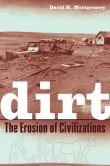.jpg) A small army of researchers and university students lugging pick axes and shovels scattered across the country for three years to scoop samples into plastic bags from nearly 5,000 places. They marked the GPS coordinates, took photos and labeled each bag before mailing them back to the government's laboratory in Denver.
A small army of researchers and university students lugging pick axes and shovels scattered across the country for three years to scoop samples into plastic bags from nearly 5,000 places. They marked the GPS coordinates, took photos and labeled each bag before mailing them back to the government's laboratory in Denver.Though always underfoot and often overlooked, dirt actually has a lot to tell. Scientists say information gleaned from it could help farmers grow better vegetables and build a better understanding of climate change. A researcher of forensic science said mud caked on a murder suspect's boots could reveal if he had traipsed through a crime scene or had been at home innocently gardening.
David Smith, who launched the U.S. Geological Survey project in 2001, said data about the dirt will feed research for a century, and he's sharing it with anyone who wants it. "The more eyes and brains that look at it, the better," Smith said.
National Soil Collection May Unlock Mysteries, Research Possibilities 'Almost Limitless'

No comments:
Post a Comment